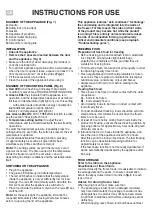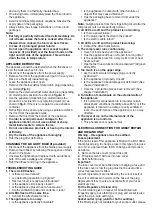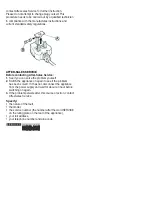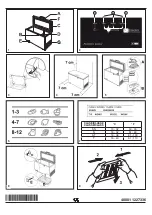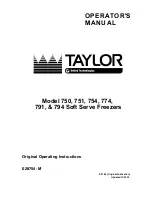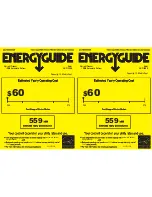
and carry them in a thermally insulated bag.
• On arriving home, immediately place the frozen food in
the appliance.
• Avoid or minimise temperature variations. Observe the
expiry date on the packaging.
• Always follow the storage instructions on frozen food
packages.
Note:
•
Eat fully or partially defrosted foods immediately. Do
not refreeze unless the food is cooked after it has
thawed. Once cooked, the food can be refrozen.
•
In case of a prolonged power failure:
Do not open the appliance door, except to place
ice packs (if provided) over the frozen foods on the
right and left side of the appliance. This will slow
down the rise in temperature.
APPLIANCE DEFROSTING
The appliance should be defrosted when the thickness of
ice on the walls reaches 5-6 mm.
• Disconnect the appliance from the power supply.
• Remove food from the appliance and put it in a very cool
place or a thermally insulated bag.
• Leave the appliance door open.
• Remove the internal defrost water drain plug (depending
on model)
(Fig. 8)
.
• Remove the external defrost water drain plug (depending
on model) and reposition it as shown in
figure 8
.
• Use the separator (depending on model) inside the
product as a recipient for any remaining water, (D) as
shown in
fig. 8
. If there is no separator, use a shallow
container.
• Defrosting can be sped up by using a spatula to detach
the frost from the appliance walls.
• Remove the frost from the bottom of the appliance.
•
In order to avoid permanent damage to the
appliance interior, do not use pointed or sharp
metal instruments to remove the ice.
•
Do not use abrasive products or heat up the interior
artificially.
•
Dry the inside of the appliance thoroughly.
•
Refit the plug after defrosting.
CHANGING THE LID LIGHT BULB (if provided)
• Disconnect the appliance from the mains power supply.
•
Remove the diffuser by following the sequence of steps
shown in the figure.
• Unscrew the light bulb and replace it with an identical
bulb of the same wattage and voltage.
•
Refit the diffuser and plug in the appliance.
TROUBLESHOOTING GUIDE
1.
The red LED flashes
.
• Is there a power failure?
• Is a defrosting operation in progress?
• Has fresh food recently been introduced?
• Is the appliance lid properly closed?
• Is the appliance placed near a heat source?
• Are the ventilation grille and condenser clean?
2.
All LEDs flash at the same time.
• Contact the After-Sales Service.
3. The appliance is too noisy.
• Is the appliance perfectly horizontal?
• Is the appliance in contact with other furniture or
objects that may cause vibrations?
• Has the packaging been removed from under the
appliance?
Note:
Gurgling noises from the refrigerating circuit after the
compressor cuts out are perfectly normal.
4.
All LEDs are off and the product is not working.
• Is there a power failure?
• Is the plug properly inserted in the socket?
• Is the electric cable intact?
5.
All LEDs are off and the product is working.
• Contact the After-Sales Service.
6.
The compressor runs continuously.
• Have hot foods been put in the appliance?
• Has the appliance lid been left open for a long time?
• Is the appliance placed in a very warm room or near
heat sources?
• Has the fast freeze function been activated? (All green
LEDs ON)
7. Too much ice on the upper edge.
• Are the defrost water drainage plugs correctly
positioned?
• Is the appliance lid properly closed?
• Is the appliance lid seal damaged or deformed? (See
chapter “Installation”)
• Have the 4 protection pieces been removed? (See
chapter “Installation”)
8. Formation of condensate on the external walls of
the appliance
.
• It is normal for condensation to form under certain
atmospheric conditions (humidity above 85%) or if the
appliance is located in a damp or poorly ventilated
room. The performance of the appliance is in no way
affected.
9. The layer of ice on the internal walls of the
appliance is not uniform.
• This phenomenon is quite normal.
ELECTRICAL CONNECTION FOR GREAT BRITAIN
AND IRELAND ONLY
Warning – this appliance must be earthed.
Fuse replacement
If the mains lead of this appliance is fitted with a BS 1363A
13amp fused plug, to change a fuse in this type of plug use
an A.S.T.A. approved fuse to BS 1362 type and proceed
as follows:
1.
Remove the fuse cover (A) and fuse (B).
2.
Fit replacement 13A fuse into fuse cover.
3.
Refit both into plug.
Important:
The fuse cover must be refitted when changing a fuse and
if the fuse cover is lost the plug must not be used until a
correct replacement is fitted.
Correct replacement are identified by the colour insert or
the colour embossed in words on the base of the plug.
Replacement fuse covers are available from your local
electrical store.
For the Republic of Ireland only
The information given in respect of Great Britain will
frequently apply, but a third type of plug and socket is also
used, the 2-pin, side earth type.
Socket outlet / plug (valid for both countries)
If the fitted plug is not suitable for your socket outlet, please

